
God knows that I never had the natural running anatomy. My toes and
knees pointed extremely inwards at birth and my mother was worried that I would have issues later in life. She sent me to PTs to try to correct the problem. I still think of how my feet should be pointing straight forward. I can still rotate my toes inwards and point them behind my center line (more than 90 degrees). I was still very athletic in my youth but never ventured into running. To put it bluntly I loathed running.
After a comment made by a PT earlier this year commenting that I have internal rotation of the femur I started reading up on my condition. Reading in Tim Noakes book "The Lure of Running" regarding common anatomical afflictions that may potentially predispose athletes to running injuries, it read:
"in its worst form, the malicious or miserable misalignment syndrome, comprising twisting (internal rotation) of the femur, squinting (kissing) patellae...."
That's me folks in a nut shell. My feet love pointing inwards and I deal with it every day. My daughter has gotten my syndrome. I keep telling her to point her feet straight forward but she forgets just like I did when I was a kid.
When I began running I started out as a heel striker. This lead to at times to the infamous runners knee, meaning the patellae moving and rubbing against cartilage leading to inflammation
of the knee. When I changed to forefoot striking (3 years ago) it all went away. Why you may ask? We'll I did a little investigation and experimentation myself first and then spoke to a orthopedic specialist after wards and he liked my demonstration and explanation. Since I have excessive kissing knees, meaning my patellas are pointing inwards when my feet are facing straight forward it is easy to show what happens with the patellae when you heel strike versus forefoot strike and it is fascinating what happens. Note that you don't have to have excessive patellae misalignment to cause runners knee.
When I put my heel down my patella is pointing inwards plus that the patellae is loose or floating (this is not good). Now when I put my forefoot down (balls of your feet not toes) my patellas are pointing straight forward like a natural runners knee and plus the patellae is fixed meaning it is not floating (which is good). If you combine the running motion with a heel strike moving over to a forefoot strike you now clearly understand the problem with runner's knee meaning the patellae is moving from one position to the other leading to rubbing. When I showed this to the orthopedic doctor he said that this is a very good explanation to tell people what happens when you have runners knee problem.
Heel position (right leg) - inward pointing patellae & floating patellae

Forefoot position (right leg) - neutral patellae position & secured patellae. Note how the patellae has moved into the proper position.

Now I will caution the person who runs out the door to change to forefoot striking that it takes patience and slow adaptation. The POSE technique is a good way to start. Do this experiment yourself and note how your patellae is locked and fixed and facing forward when standing on your forefoot (balls of your feet not toes) versus putting your heel down (feel how the patellae is floating). I have never had any knee problems when moving over to forefoot striking. Now even if you have a neutral stance and heel strike it still leaves the patellae in a floating position leaving it open to movement. And if you land on uneven ground the patellae is sure to move around which subsequently leaves the knee vulnerable. Heel striking is in my opinion why running has gotten a bad rap.
Best Carl


